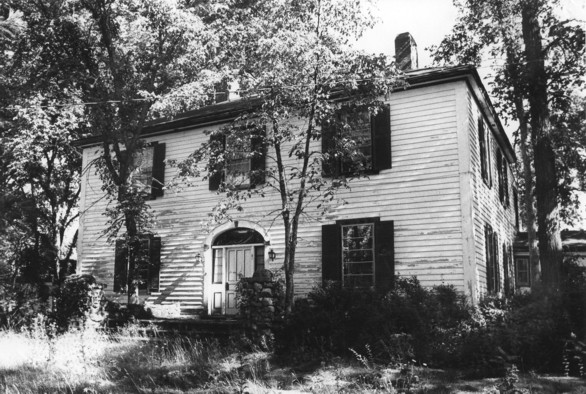
Indeed, there are at least 100 buildings in Chatham constructed between 1824 and 1900, most of them researched and documented.
The atmosphere in Chatham takes one back in imagination to the days when lumbering and shipbuilding were booming and there were giants of men who constructed large and beautiful homes and made names for themselves in industry and politics.
Approaching the town from the west and crossing the causeway at Morrison Cove, just off to the right one sees the chimneys of Woodburn Farm. This was the home of Henry Cunard, one of the famous Cunard brothers. Henry was a gentleman farmer, a store owner and mill operator. He and his brother, Joseph, who dominated the business and political life of the Miramichi, came to Chatham about 1823. Another brother, Samuel, stayed in Halifax and founded the Cunard Steamship Line.

Woodburn Farm is an excellent example of Georgian architecture and was constructed about 1841 by Alexander Cormack.
Closer to the centre of town is the Tweedie house, the home of Lemuel J. Tweedie who practised law in Chatham from 1870 until his death in 1917. He had a distinguished career in politics--Premier of New Brunswick from 1900 to 1907 and Lieutenant-Governor from 1907 to 1912. This house was also built by Alexander Cormack for George Kerr, a lawyer and an MLA, and is notable for perfect proportions and beautiful interior woodwork.
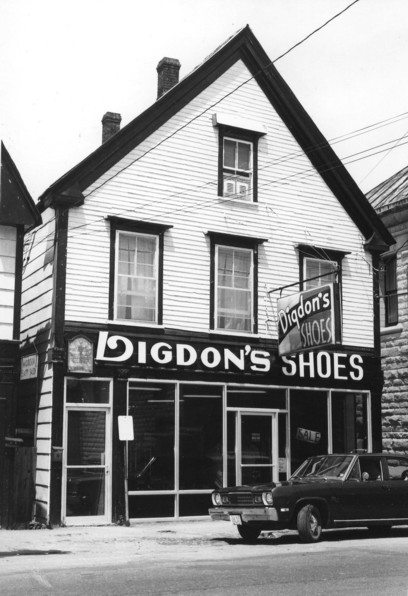 |
The L. J. Tweedie law office
was on the second floor of this building. Here R. B. Bennett
and Max Aitken, later Lord Beaverbrook, studied law. Above
the door is a plaque placed there by the Town of Chatham in
1953. Lord Beaverbrook visited the town for the ceremony.
(Dewey photo) |
The Tweedie law office was on the second floor of the Water Street building, now owned by Digdon's Shoes. Articling with Mr. Tweedie in 1891 was a young man named R. B. Bennett, who became a partner in 1893. Also articling for a short time was Max Aitken, only sixteen years old at the time. He was a great admirer of Bennett and, when Bennett decided to go to Calgary in 1897, Max Aitken was desolate. He left shortly afterward with the intention of studying law. Although he was never to become a lawyer, he did become Lord Beaverbrook. R. B. Bennett, of course, went on to become Prime Minister of Canada.
There are many buildings on Water Street notable for both architecture and historical interest. The John T. Williston stone house, built by 1824, is believed to be the oldest building in Chatham. It was built by Mason Andrew Currie. Its first owner, J. T. Williston, was a lawyer and a member of the Legislature who figured prominently in the "fighting election" of 1843. From the time of Williston's death in 1865, the house played many roles, including that of the Chatham Post Office.
| Adjoining it is the Flat Iron Building, so named because of its odd shape. The first owner was John Bannon, a shoemaker. The land on which the building stands was purchased from John T. Williston in 1847. | 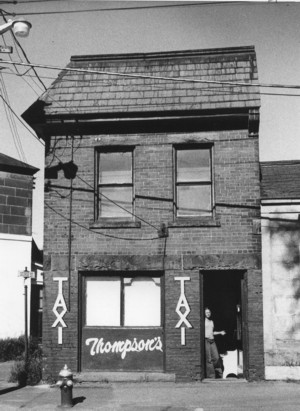 |
 |
Just east across a narrow street is the Pallen building, of Scottish ballast stone, also the work of Andrew Currie. In 1854 it was acquired by Dr. John Pallen who came to Chatham from Bathurst in 1837. A weekly newspaper, The Colonial Times, was located there in 1856 and in the ensuing years the building has housed a variety of businesses. |
The oldest commercial building is the old W. S. Loggie store. It was built prior to 1838 by Joseph Cunard whose stone store was situated a few buildings above it and whose elegant mansion was slightly east on the other side of the street.

Scores of businesses have been carried on within the walls of the Commercial Building. In 1873, W. S. Loggie opened a retail business which continued to operate until very recently.
lt is interesting to note that the Gleaner office was located for a time in what was later the Loggie shoe store. Publisher James A. Pierce made news himself in 1837 when he printed that Lemual A. Wilmot, MLA, had told an "untruth". Pierce was arrested and taken to the York County jail where he remained for twenty-two days without trial or appearance. When the Legislature prorogued, he was released and returned home to a hero's welcome. Needless to say, the government of the day was attacked for infringing on the freedom of the press. The Pierce house, a large double building halfway up King Street, is still well preserved and, until 1956, remained in the Pierce family.
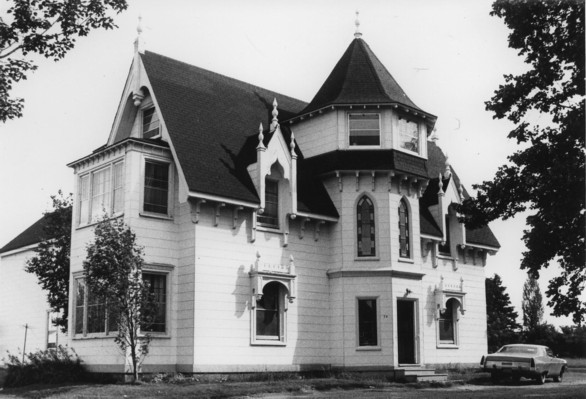
Further along King Street, heading toward Canadian Forces Base Chatham, stands "Blink Bonnie". A beautiful example of Gothic architecture, it was also built by Alexander Cormack for George H. Russell, a Chatham merchant. Although it was altered considerably in later years, it ranks as one of Chatham's most striking houses. Henry Muirhead of the well known lumbering family lived here until he died in 1895.
The huge three-storey house on Wellington Street was built by George Cassady in 1879 for the Loggie family. With its mansard roof, it is a perfect example of late Victorian architecture, Second Empire style. W. S. Loggie was a prominent businessman and Member of Parliament and the W. S. Loggie Company was prominent in the business life of the Miramichi area for a hundred years. At one time, the company had forty-five canneries in New Brunswick, Prince Edward Island and Quebec. The last Loggie to live in the house was Leigh Loggie, a son of W. S. Loggie, who died in 1977. The house, with its five out-buildings and two acres of land, was purchased by the Town of Chatham in 1979 and is now the W. S. Loggie Cultural Centre.
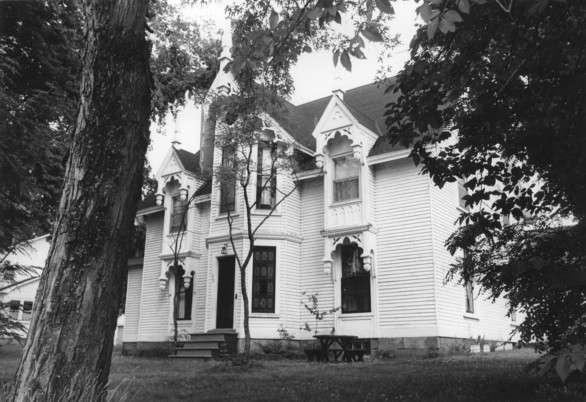
"Wellington Villa" the home of Jabez Bunting Snowball, on the corner of Wellington and King, is very similar in design to "Blink Bonnie". J. B. Snowball was a lumber baron whose company owned several mills and tugboats. In a busy season, he employed 900 men. He was involved in a number of other successful enterprises in connection with the railway, the electric light and the telephone.
Active in politics, he was elected to the House of Commons in 1878 and was later appointed to the Senate, a position he resigned to become Lieutenant-Governor of New Brunswick. When he died in 1907 he was succeeded by another Chatham notable, L. J. Tweedie.
There is no doubt that Chatham's history is one of achievement and that its buildings all have stories to tell.
(The Atlantic Advocate, April 1982)